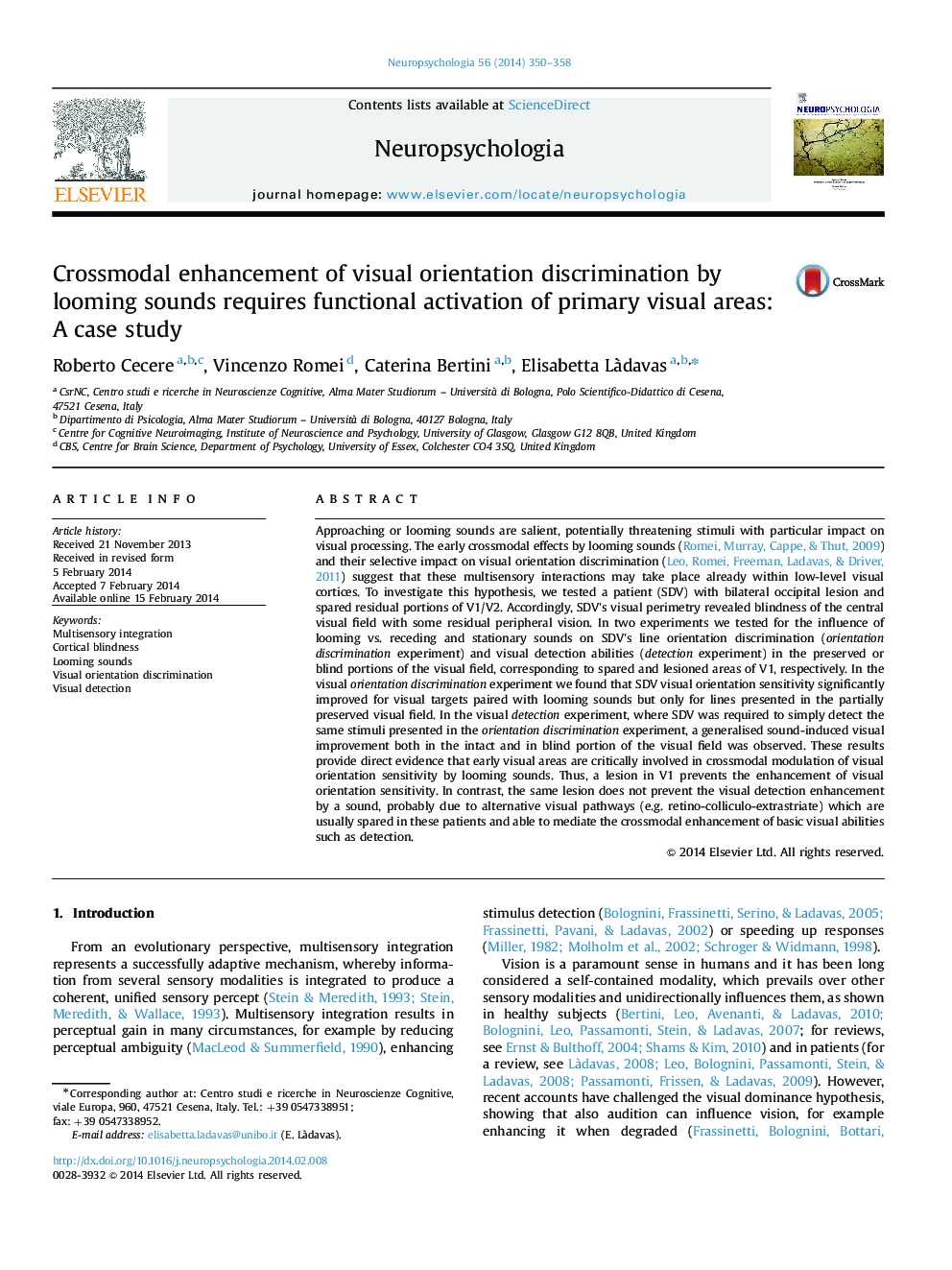| کد مقاله | کد نشریه | سال انتشار | مقاله انگلیسی | نسخه تمام متن |
|---|---|---|---|---|
| 7321725 | 1475597 | 2014 | 9 صفحه PDF | دانلود رایگان |
عنوان انگلیسی مقاله ISI
Crossmodal enhancement of visual orientation discrimination by looming sounds requires functional activation of primary visual areas: A case study
ترجمه فارسی عنوان
تقویت ترانسدیادال از تبعیض جهت گیری بصری با صداهای ناخوشایند، نیاز به فعالسازی مناطق بصری اولیه است: مطالعه موردی
دانلود مقاله + سفارش ترجمه
دانلود مقاله ISI انگلیسی
رایگان برای ایرانیان
کلمات کلیدی
یکپارچه سازی چند جانبه، کورکورانه، برای تلفن های موبایل تبعیض جهت گیری بصری، تشخیص ویژوال،
موضوعات مرتبط
علوم زیستی و بیوفناوری
علم عصب شناسی
علوم اعصاب رفتاری
چکیده انگلیسی
Approaching or looming sounds are salient, potentially threatening stimuli with particular impact on visual processing. The early crossmodal effects by looming sounds (Romei, Murray, Cappe, & Thut, 2009) and their selective impact on visual orientation discrimination (Leo, Romei, Freeman, Ladavas, & Driver, 2011) suggest that these multisensory interactions may take place already within low-level visual cortices. To investigate this hypothesis, we tested a patient (SDV) with bilateral occipital lesion and spared residual portions of V1/V2. Accordingly, SDV׳s visual perimetry revealed blindness of the central visual field with some residual peripheral vision. In two experiments we tested for the influence of looming vs. receding and stationary sounds on SDV׳s line orientation discrimination (orientation discrimination experiment) and visual detection abilities (detection experiment) in the preserved or blind portions of the visual field, corresponding to spared and lesioned areas of V1, respectively. In the visual orientation discrimination experiment we found that SDV visual orientation sensitivity significantly improved for visual targets paired with looming sounds but only for lines presented in the partially preserved visual field. In the visual detection experiment, where SDV was required to simply detect the same stimuli presented in the orientation discrimination experiment, a generalised sound-induced visual improvement both in the intact and in blind portion of the visual field was observed. These results provide direct evidence that early visual areas are critically involved in crossmodal modulation of visual orientation sensitivity by looming sounds. Thus, a lesion in V1 prevents the enhancement of visual orientation sensitivity. In contrast, the same lesion does not prevent the visual detection enhancement by a sound, probably due to alternative visual pathways (e.g. retino-colliculo-extrastriate) which are usually spared in these patients and able to mediate the crossmodal enhancement of basic visual abilities such as detection.
ناشر
Database: Elsevier - ScienceDirect (ساینس دایرکت)
Journal: Neuropsychologia - Volume 56, April 2014, Pages 350-358
Journal: Neuropsychologia - Volume 56, April 2014, Pages 350-358
نویسندگان
Roberto Cecere, Vincenzo Romei, Caterina Bertini, Elisabetta LÃ davas,
